This morning, we looked back at the stories that made it big. Before we turn the page to 2014, let’s look at four stories that can fall through the cracks at the end of a day, but are too big to ignore at the end of a year.
Maybe 10 million times in the last year, a Portlander got on a bicycle to go somewhere. Here’s how many of them survived it: every single one.
There were several serious collisions, covered here on the site, including one major hit-and-run that remains unsolved. But the number-one reason Portland is the country’s best big city for biking is that this is, compared to any other large U.S. city and lots of the smaller ones, an extremely safe place to ride a bicycle.
This isn’t a new feat for Portland: the city also avoided any bike-related fatalities in 1999, 2000, 2002, 2006, 2008 and 2010. That’s a safety record that’s nearly unmatched from coast to coast, and it’s something to raise a glass for this evening.
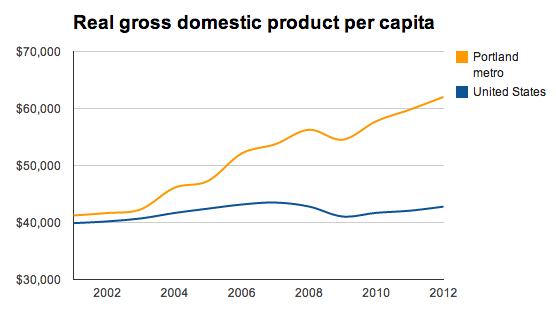
Why is this a bike story? Because in the national psyche and in our city’s own, Portland means biking and biking means Portland. When people think Portland is an economic basket case, they look for scapegoats. In recent years, bikes have gotten blamed.
That’s always been nonsense, but numbers released this year should nail that coffin shut for good.
When Portlandia premiered in January 2011, it turns out, the Portland area was already swinging out of its slump. This September, the Bureau of Economic Analysis announced that only two major metro areas in the country (San Francisco and New Orleans) saw faster real GDP growth per capita last year than Portland. Since 2001, no major metro in the country has done better.
You might have also heard a storyline claiming that Portland mooches off job growth in its more auto-oriented western suburbs. That’s baloney, too. Washington County has added 11,700 jobs since 2011 (4.7 percent growth), and that’s great. Multnomah County, meanwhile, has added 20,600 jobs (4.6 percent growth).
Even more intriguingly, there’s plenty of evidence that the things bikes have helped do for the Portland area — lowered living costs, pollution and sprawl — have been a big driver for our relative economic success.
“What we have is a skill-based economy where we need smart people,” state economist Christian Kaylor said in an interview Tuesday, explaining why Multnomah County has been “dominating” Oregon job creation over the last two years. “Hospitals need doctors, engineering companies need engineers, computer programming companies need computer programmers. Those companies don’t run on coal, they don’t run on timber, they don’t run on a port. What they care about is highly educated people — that’s the resource they need. That’s their oxygen. So who wins in that? The community that can attract highly educated people.”
On that measure, Kaylor said, Portland has been lapping the field. The city has absorbed 45 percent of the region’s population growth since 2007, quadruple its rate in the 90s. More than half of new arrivals have college degrees, and employers have been following them into town.
“It’s as good for economic development, I think, as having a major university,” Kaylor said. “This is something we haven’t seen since the 1940s, with the Liberty Shipyards, when the City of Portland is growing economically faster than the rest of the region.”
The Portland area is far from an economic paradise, and like every U.S. city it struggles to help everyone share in the wealth it has. But in 2014, resolve never to let anybody get away with arguing that pro-bike policies have been stifling Portland’s economic growth. It’s just the opposite.
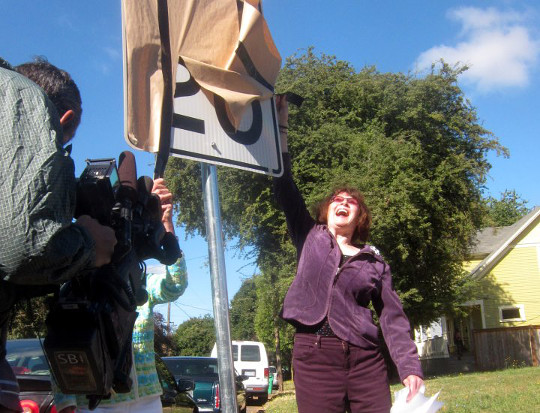
city’s first 20 mph speed limit signs.
(Photo by M.Andersen/BikePortland)
When it comes to using protected and buffered bike lanes to make big corridors bike-friendlier, Portland has fallen well behind the leading U.S. cities (though it did add 4 miles of new buffered bike lanes in 2013, most prominently a 2-mile stretch of Southwest Beaverton-Hillsdale Highway).
But Portland does still have a solid claim to bike-infrastructure leadership in the United States: its neighborhood greenway network, on which it continues to remove center lines (as it did this year on outer Alberta, inner Ankeny and inner Flint), flip stop signs and install about 1,600 new “20 mph” signs in recognition of the network’s new, lower speed limit.
If neighborhood greenways have a shortcoming, it’s that a lot of beginning bikers don’t even realize that they form an interconnected grid. But for those of us who are in on the secret — and thanks to the city’s booming Safe Routes to Schools program, more and more of us are — the greenways are a great way to get around. That’s why Seattle, Chicago and Washington County are rushing to imitate them.
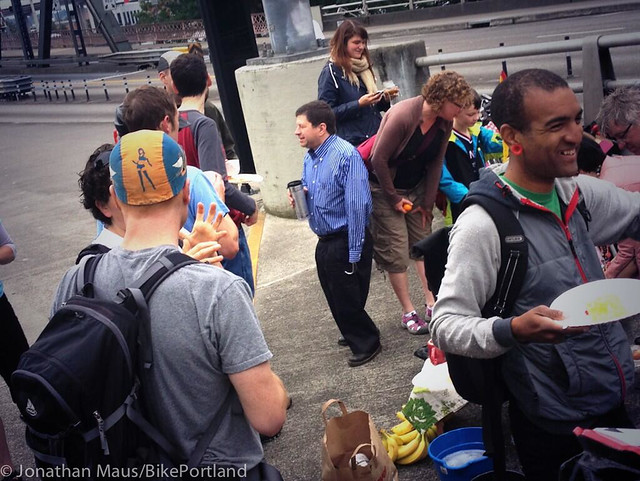
(Photo by J.Maus/BikePortland)
Spend a minute reflecting on this string of events: Before leaving office, the pro-bike politician who oversaw a city’s transportation policy for eight years tries to install his even more pro-bike protege (who also shared some of his boss’s sharp-elbowed style and ethically problematic actions) to run the department after he leaves. The new transportation chief fires or lays off several senior staffers, reorganizes the bureau and announces significant strategic reforms but his unpopularity comes home to roost and the new mayor forces the new guy from office.
In another city, that would be a disaster for biking. But here in Portland, the extremely pro-bike politician was succeeded by two moderately pro-bike politicians, who installed a publicly pro-bike director with a more low-key style.
“Bicycle” isn’t currently a word you’ll hear much in City Hall. That’s a big change and a sad one. But it’s remarkable that the epic political crossfire that surrounded Mayor Sam Adams’ departure hasn’t been significantly worse news for people who use bikes. The fact that it hasn’t is a tribute to the fact that, when you come right down to it, it’s become totally mainstream in Portland to think that bicycles are awesome.
That’s as good a foundation as any to build the future on.


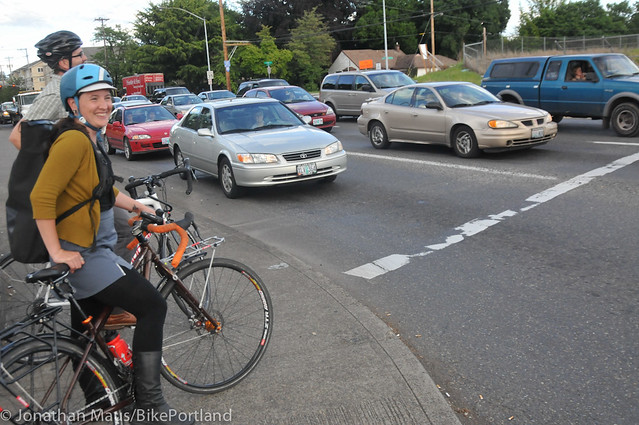

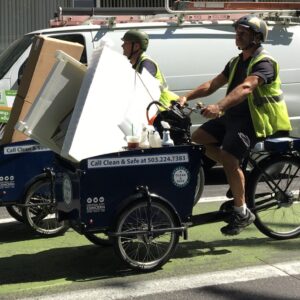
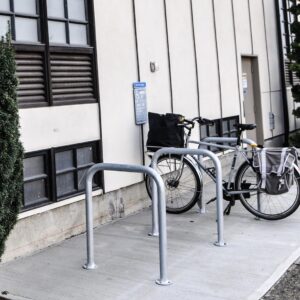
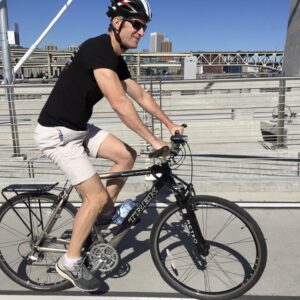
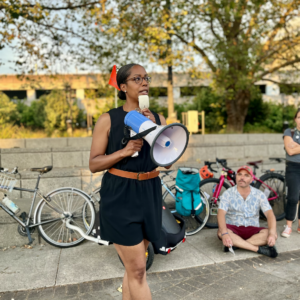
Thanks for reading.
BikePortland has served this community with independent community journalism since 2005. We rely on subscriptions from readers like you to survive. Your financial support is vital in keeping this valuable resource alive and well.
Please subscribe today to strengthen and expand our work.
any stats for how many automobile related fatalities there were in Portland for 2013?
34 total. I believe 11 were pedestrian fatalities killed by motorists, with 9 deaths occurring near Barbur and Terrwilliger/Miles Place.
Yeah, but as a percentage of people who use/miles traveled via a particular travel mode…oh, wait…[mumbles]let’s see…zero percent means…so if…huh…why is my car ‘safer’ again?…
Also on the zero fatalities statistic, I don’t know if anyone is estimating person miles traveled by bike in the region (since we don’ buy gas this is harder to do than for people driving), but it would be interesting to perhaps show the relationship as ridership/miles biked goes up.
Perhaps the City should consider installing a sign at each major bike entry point (G. Jackson Bridge, Interstate Bridge, etc.) noting “X Days” since last bicyclist [traffic related] fatality. There are similar signs at job sites, and also others for “Tree Cities” etc.
Great piece. I remember years ago when I worked for a big paper company in R&D, how we could hire good people for much less money due to good old “QoL.” Now some of that was the mountains, the beach, the Gorge, but even those nature resources have been protected and made more accessible by good public policy. Yes, Quality of Life replaces the one thing Portland does not have…no knock on PSU cause they are trying like hell…a major research university.
Michael, can you get some numbers on the amount of fuel NOT purchased here due to our bike friendly/low car possibilities and covert that into the amount of beer, books, food, coffee and other locally produced goods and services purchased. Its a kind of “import substitution” that Jane Jacobs talks about in “Cities and the Wealth of Nations”…a great little book!
Great, uplifting piece, Michael. I’m reading it just before midnight on New Year’s Eve, and it’s giving me such a positive feeling to start the new year on. Thanks!
I think the caption showing Sen. Burdick unveiling of the “first” 20 MPH speed limit sign is not correct. SW Capitol Highway has been posted at 20 MPH in the Multnomah Village area for many years now. Unfortunately, driver compliance with this speed limit is not very consistent…
don’t tell wsbob that. 🙂
Thanks – changed to “one of the first.”
SW Capitol Hwy: that’s a business district speed limit permited by state statute, not a Neighborhood Greenway route. NE Fremont has one as well.
Your claim that “…driver compliance with this speed limit is not very consistent… .”, is based on what? Your own offhand observation? The same kind of observations on the part of neighborhood residents? Results from police enforcement details that may or may not have been conducted on the road? A actual study that may or may not have been conducted on the road?
Without at least some mention of one or other of the aforementioned, statements like “…”…driver compliance with this speed limit is not very consistent… .”, just doesn’t offer much information.
Jeese louise wsbob – “compliance isn’t very consistent” isn’t exactly an overreach of a statement. Give it a rest.
I didn’t say the statement was overreaching. What I said, is that it doesn’t offer much information…and it doesn’t. Of course if you’re happy with it…fine.
Some people, interested in actually determining the causes of various problem situations, and how to best arrive at possible means of correcting, may want a little more information than “compliance isn’t very consistent”.
Thanks guys! This is a great note to start out 2014 on. Hoping we can get a few more buffered lanes on the ground/in the plans this year…
Economics is a great angle – if Portland wants to win it needs to double down on human friendly streets. I have met so many talented energetic people who say what brought them here was the prospect of being able to get around without a car (or fear of getting hit). It’s hard to imagine a better investment in our community than accelerating the unwinding of the auto era that we pioneered in the 90s. Dollar for dollar nothing beats catering to self propelled humans. If I were in charge I’d start by extending the Greenways as far East as practicable, and do anything to mitigate the neighborhood isolating Robert Moses legacy. These dollars have a multiplier effect, compared to good money after bad w CRC or whatever other backward looking stuff still drives decision making. Yet paradoxically it’s the low return projects that have the high price tags.
Happy New Year and let’s hope it’s one of rational tax dollar expenditure.
car·nage (kärnj)
n.
1. Massive slaughter, as in war; a massacre.
2. Corpses, especially of those killed in battle.
That is the definition of the word. When searching this word in the search-box, this site provides 6 results for stories written this year.
But according to this story, no fatalities for people on bikes happened this year.
Something is not adding up.
http://www.merriam-webster.com/dictionary/carnage
#2 – great and usually bloody slaughter or injury
Not that I’m a fan of using the word carnage. Too punny and over the top for my taste.
Pretty good point, Itgoestbothways. A couple responses, from two of the posts you mention: one was a podcast episode that included a 15-minute discussion about whether or not it’s a good idea for us to cover collisions at all.
Also, you might read Jonathan’s editorial kicking off our “mini-advocacy campaign” this summer. He mentioned one person crippled while riding on a bike, two killed in car crashes, one killed while dribbling a soccer ball down a road and one nearly killed by his plummeting semi truck. When we use the word “carnage,” it’s in the larger context of a road system that, for all its importance and advantages, killed more Americans last year than firearms, wars, terrorism and many varieties of cancer.
Jonathan kicked this off after returning from Northern Europe, where 40 years ago there was a mass movement that declared this status quo to be unacceptable. So they decided to try to change it, and it worked. Today, that’s resulted in the lowest road fatality rates in the world for all users and helped create some of the world’s happiest, most prosperous and most egalitarian countries. I respect your questioning of our attitudes, and I think you’re right that I, for one, overplay this attitude sometimes! But if Scandinavian attitudes about road safety don’t strike you, in general, as awesome and worth emulating, I don’t understand that, either.
Portland’s streets today are the result of ten years of dedicated advocacy, organized and otherwise, and careful work. We’re moving in the right direction, and I think it’s exciting to watch.
Thanks for the thoughtful comment.
Michael, you really need a history lesson; lots of dedicated people have been working on bike issues in Portland for a LOT longer than 10 years. Yes, we hit the knee of the curve about 10 years and things really took off, but that would never have happened without the 25+ years of work that came before that. It still amazes me how quickly BikePortland starts to talk about bike improvements stagnating in Portland — the generation of instant gratification I guess.
Dave, you’re totally right — my phrasing was wrong. I was thinking about the safety improvement over the last 10 years (which has been dramatic) but of course this is the result of multiple generations of activism and good policy. Thank you.
i’ve never understood why adams developed a reputation of being very pro-bike. i think he was a bit of a transportation wonk but i consider someone who actually commutes by bike to be far more “pro bike” than someone who drove a truck/prius for transport (from a relatively close-in home).
Michael, I’m investigating what actions San Jose, California could take to improve its dismal traffic safety situation (41 fatalities in 2013, 25 of those were people walking or cycling), and this article reminded me that Portland probably has some great ideas for us here in the Bay Area.
Has the city of Portland written any reports describing what actions have improved traffic safety so much? Some kind of “traffic safety program analysis”? If not, who should I contact at the city or elsewhere to learn? Who is Portland’s “traffic safety expert”? I’m interested in safety for people walking, cycling, and driving. Thanks.
Hi Andrew,
I’ve never seen a report exactly like that, but there is a lot of analysis and documentation available. I’d start by checking out PBOT’s Neighborhood Greenway, Crosswalk Enforcement Action, High Crash Corridors, and Community & Schools Traffic Safety Partnership programs. Those are just some of the work PBOT does to make streets safer. Another big thing is our traffic signals department. They are doing some innovative stuff to make sure that walking and biking are both efficient and safer.
Here’s a good page on the PBOT website for more info:
https://www.portlandoregon.gov/transportation/article/299189
As for the main traffic safety expert at PBOT, look no further than Greg Raisman… You can email him at greg.raisman at portlandoregon dot gov
cheers and good luck.